

June 2015
IN THIS ISSUE:
![]()
- One disease: two approaches
- Alan Alda and Roger Rosenblatt discuss how NIH can effectively communicate science
- Interns graduate Project SEARCH-NIH Program, eight hired at NIH
- Clinical Center celebrates the dedication of nursing workforce
- 'Future doctors of America' present research accomplishments
- NIH Blood Bank has new location off campus for platelet donation
- Patients, staff gather as panelists to discuss importance of women's health
- NIH Minority Health Promotion Day
- Children arrive at the Clinical Center for a day of discovery
- NIH recruiting for upcoming studies
- Upcoming Events
Print this Issue ![]() (578 KB)
(578 KB)
ABOUT CC NEWS:
![]()
Published monthly by the Office of Communications and Media Relations. News, article ideas, calendar events, letters, and photographs are welcome. Submissions may be edited.
Clinical Center News
National Institutes of Health
Building 10, 10 Center Drive
Room 6-2551,
Bethesda, MD 20892-1504
Tel: 301-594-5789
Fax: 301-402-0244
Molly.hooven@nih.gov
QUICK LINKS:
![]()
One disease: two approaches
 |
Dr. Richard Childs, from the National Heart, Lung, and Blood Institute, answers a question from the audience at a Clinical Center Grand Rounds lecture. Childs participated in the U.S. Public Health Service Commissioned Corps response to the Ebola crisis in Liberia. Dr. Anthony Suffredini from the Clinical Center also presented at the lecture. |
Lecture shows how treating Ebola in Liberia and the Clinical Center required distinct strategies
Imagine having to perform a life-saving procedure. Now imagine having to do that same work in a diver's suit. That was the reality for Clinical Center clinicians working to save patients from Ebola virus infections.
On May 27, the Clinical Center hosted a Grand Rounds lecture, Ebola: From the Monrovia Medical Unit to the ICU, which featured two medical professionals with different experiences in treating Ebola.
Dr. Anthony Suffredini, the deputy director of the Department of Critical Care Medicine, gave an overview of the pathogenesis and pathology of Ebola. He also outlined the challenges in providing care for critically-ill patients with Ebola virus disease.
Due to Ebola's highly infectious nature, unique treatment strategies must be adopted to care for infected patients. Health care workers must wear personal protective equipment (PPE) to limit any exposure to the highly-contagious bodily fluids from patients. In West Africa, the elevated temperature and humidity in the treatment facilities limit the time that health care workers in PPE can spend with patients. In contrast, the controlled environmental conditions in the U.S. and Europe allow for continuous bedside care for patients.
Diagnostic testing and imaging for patients are also limited due to the infectious risk posed by the patients' body fluids.
Captain Dr. Richard Childs, clinical director, senior investigator and chief for the transplantation Immunotherapy Section of the Hematology Branch for the National Heart, Blood and Lung Institute, then spoke on the U.S. Public Health Service (USPHS) Commissioned Corps Ebola response in Liberia and his experience caring for patients at the Monrovia Medical Unit (MMU).
Four teams comprised of USPHS Commissioned Corps officers were deployed to run and staff the MMU. The 25-bed, state-of-the-art field hospital was designed to treat health care workers who became infected with Ebola while tending to patients. The MMU opened its doors to Ebola patients Nov. 7, 2014. The unit was the only U.S. government entity to provide direct care to patients infected with Ebola in West Africa.
Childs outlined the safety procedures while treating patients: PPE was worn when seeing patients; all skin was covered; all gloves were double or triple-layered; PPE was decontaminated with bleach when removed; and safety officers coordinated with medical providers and nursing staff prior to patient visits.
The unique environment in Liberia meant that specific procedures had to be followed to ensure the safety of the team. Caregivers monitored their vital signs before and after entering treatment areas. Anyone with a heart rate higher than 100 beats per minute, which is the upper range of a normal resting heart rate for adults, was not allowed to tend to patients. Due to the high temperatures, staff could only wear PPE for a maximum of two hours to avoid dehydration. This meant the team was unable to provide 24-hour continuous bedside observation of patients.
The field hospital admitted 42 patients, including 18 with Ebola and 24 with suspected Ebola virus. Remarkably, amongst the 18 patients with Ebola, all of whom were severely or critically ill, 10 survived.
"The mission of the MMU proved highly successful; survival rates were higher than those observed amongst conventional Ebola treatment units and it provided a safety net for health care providers and helped Liberia through its Ebola epidemic," said Childs.
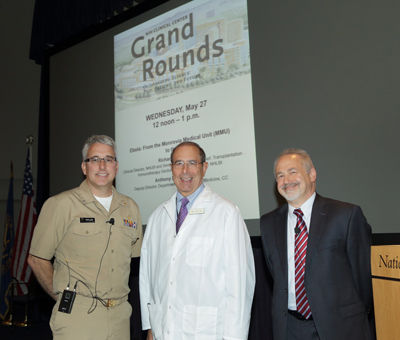 |
Dr. Richard Childs, from the National Heart, Lung, and Blood Institute, Dr. John I. Gallin, the director of the Clinical Center, and Dr. Anthony Suffredini, from the Clinical Center’s Department of Critical Care Medicine gathered after the Grand Rounds lecture. |
Despite the dangers involved in caring for these patients, all 283 of the team members (26 of whom were from NIH) returned safely and free of infection.
Suffredini closed the lecture by describing the experience of treating a patient with Ebola in the Clinical Center's Special Clinical Studies Unit. He reviewed the symptoms of Ebola, drawing on published reports of the treatment of the seven different patients treated in the U.S. He detailed the assessments and treatment of a patient treated at NIH this past March and April. The patient was transported from West Africa and arrived at NIH on the sixth day of his illness.
The symptoms started as profound weakness, skin rash, diarrhea and high fever for this patient but deteriorated to inflammation of the liver, low blood platelet counts, lung failure, confusion and delirium as well as kidney failure. As the infection began to resolve with treatment, the patient also experienced short-term memory loss, difficulty concentrating and eye inflammation.
After successful treatment, the Clinical Center discharged the patient April 9. Exactly one month later, Liberia was declared Ebola-free.
Suffredini cited several factors necessary in cultivating a successful medical strategy for treating Ebola-infected patients. These included leadership, teamwork and volunteerism.
"The Clinical Center had 19 different departments and specialties that worked together to help treat the Ebola-infected patient," said Suffredini. "Each one played a role in the patient's treatment and recovery."
Alan Alda and Roger Rosenblatt discuss how NIH can effectively communicate science
 |
Dr. Francis Collins, director of the NIH, welcomed NIH staff to the sixth of a series of lectures dedicated to innovation, invention and scientific discovery with Alan Alda (left) and Roger Rosenblatt (right). |
The NIH Clinical Center welcomed Alan Alda, actor, director and screenwriter, and Roger Rosenblatt, essayist, novelist and playwright, to talk to staff about the merging of arts and sciences and the conversational way to communicate science at the NIH.
Alda, commonly known for his role as Hawkeye Pierce in M*A*S*H, and Rosenblatt, who's written for the Washington Post, Time Magazine and PBS NewsHour, brought the crowd to roaring laughter multiple times as they recalled their experience in successfully, and not so successfully, engaging with an audience, telling a story and making a 'powerful point' without a PowerPoint presentation.
Both Alda and Rosenblatt come from the Center for Communicating Science at Stony Brook University. Alda founded the center and Rosenblatt serves as a distinguished professor of English and writing. The May 21 event was a part of an innovation lecture series held by the National Institute of Mental Health.
The lecture filled Masur Auditorium and drew over 1,500 views on videocast. Below, Rosenblatt and Alda, challenge staff to become better communicators and offer techniques and advice to help.
- "The center of all of this is telling a story. It's the way that we can trust one another and gather from one another what is most valuable. We learn from stories. We live in the world of narration." – Rosenblatt said in hopes that scientists will be able to share a message about their work as if they were telling a story to a friend.
- "If the true story is not told as a story that's compelling, it won't be understood and it won't be remembered. We remember things that have an emotional tinge to them. To excite the brains of the people listening, with a word or two or situation that helps them feel something, will help them not just engage with it, but it will really help them remember it." - Alda said, while encouraging scientists not to 'dumb things down,' but, rather, convey a meaningful message that is usable.
- "Sometimes the analogy in writing, use of metaphor for example, can elevate the meaning both of the person who wishes to communicate the idea through analogy and the person receiving the analogy, so that both reach a kind of a plane of thought which doesn't violate the truth at all." – Rosenblatt
- "I wanted to see that conversational tone and the conversational language, the conversational vocabulary used by scientists when somebody like me wasn't there pulling it out of them." – Alda said as he explained that he'd often have to say to scientists 'I don't get it, what do you mean?'
- "You will sacrifice a certain amount of imaginative work in order to make it comprehensible." – Roger Rosenblatt, in reference to telling a compelling story about scientific discoveries and other accomplishments
- "If you can convey the essence [of your science] to somebody who hasn't heard about this before, I think you've accomplished something enormous. You don't have to then go on and tell them everything you know about it because you're likely to get eyes glazing over. If you can achieve interest and desire to know more, that's a big accomplishment." – Alan Alda
Interns graduate Project SEARCH-NIH Program, eight hired at NIH
 |
Project SEARCH graduates gathered June 5 to celebrate their accomplishment with family, friends, co-workers and supervisors. From left to right: (back row) Kerem Kolan, Adam Hoffman, Christopher Frawley, Yuchen Gu, (front row) Meredith Beck, Hayley Doyle, Chris Pagonis, Lydia Vreeland, Melissa Tebi. Not pictured: Rachel Williams |
The Clinical Center celebrated the fifth graduating class of the Project SEARCH-NIH Program June 5. Project SEARCH provides young adults with intellectual and developmental disabilities the opportunity for vocational education and training to prepare for competitive employment opportunities.
Since 2010, 53 interns have graduated and 36 have been hired at the NIH – a 79% hire rate! More than 80% of those who were hired by the NIH are still employed in their position.
Meredith Beck, along with eight other 2015 graduates of the internship program, will transition from their role as a Project SEARCH intern to an NIH staff member.
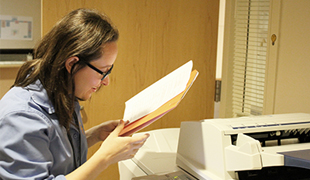 |
Meredith Beck and other fellow 2015 graduates of the Project SEARCH internship will soon transition into a new role as an NIH staff member. |
Beck enables the Clinical Center Office of Administrative Management to conduct their work more efficiently by streamlining the process for analyzing funding packages. She enjoys interacting with the people whom she works with and others that she meets inside the Clinical Center.
"I joined the Project SEARCH Program because it looked interesting when I researched it," said Beck. "I'm so happy that I decided to participate and I'm excited to begin my new job here at the Clinical Center!"
Learn more about 10 month Project SEARCH program at NIH and its partners.
Clinical Center celebrates the dedication of nursing workforce
To recognize the hard work of the nursing staff, who provide both clinical research expertise and health care to patients, the Clinical Center celebrated Nurses' Week May 6-12. Activities included a breakfast, afternoon reception and an evening shift snack cart; lectures on the ethics of caregiving and provider challenges and the critical role of the oncology nurse; a U.S. Public Health Service nurse recognition webinar and other daily events sponsored by individual patient units. The week was hosted by the Nursing Department's Recognition and Retention Committee in partnership with Nursing Department leadership.
 |
Nursing Department executive leadership served their dedicated colleagues a warm breakfast after their night shift during Nurses’ Week. From left to right, Dr. Barbara Jordan, Diane Walsh, Dr. Gwen Wallen, CAPT Ann Marie Matlock, Dr. Clare Hastings, Dr. Deb Kolakowski, Ray Nudo and Dr. Cheryl Fisher. |
'Future doctors of America' present research accomplishments
Medical Research Scholars Program says farewell to third class, welcomes 55 students in the fall
 |
The NIH trains the next generation of clinician-scientists and biomedical researchers, including the third graduating class of Medical Research Scholars Program participants above. |
With nearly a year of NIH research completed, 42 Medical Research Scholars Program (MRSP) participants presented their scientific research to the NIH community and guests May 11-12 in the Foundation for Advanced Education in the Sciences classrooms and terrace.
During the two-day event, these medical, dental and veterinary students presented on topics such as adoptive cell transfer targeting unique cancer mutations; focal electro-oculogram for use in macular diseases; visual exploration in Parkinson's disease; stress reactivity of cortisol in a nationally-representative sample of adolescents; and MRI/Ultrasound fusion-guided targeted biopsy detecting clinically-significant prostate cancer in the central gland correlating with index lesion. The presentations summarized their mentored biomedical research projects with an NIH investigator who matched students research interests and career goals.
In addition to the oral presentations, poster sessions were added to the event for the first time.
Dr. Susan Leitman, director of the MRSP, praised the 2014-2015 class and credited them as "poised, professional, confident, highly-knowledgeable, data-driven and well-spoken" individuals who "showed a real understanding of science in general and scientific method and analysis."
MRSP scholar Abdulkareem Agunbiade, a third-year medical student at the University of Chicago Pritzker School of Medicine stated, "One of the favorite things I like about the MRSP is that I have the great opportunity to live with, bond with and learn from the future doctors of America."
Fellow MRSP scholar Taufiq Salahuddin, a third-year medical student at Wake Forest University School of Medicine, also said "From mentorship with your [principal investigator] to faculty within the MRSP and the NIH in general – everybody is very supportive. Just living with 41 other Medical Research Scholars has been incredibly awesome."
In late April, the NIH announced the 2015-2016 MRSP class, the fourth and largest class in the program's history. The 55 talented and diverse students include 25 females and 13 students from underrepresented minority groups. The new class will travel from their 37 U.S.–accredited universities to the NIH campus to begin their basic, clinical or translational research in August 2015.
Learn more about the poster presentation topics, scholars and MRSP. View details on the new 2015-2016 class.
NIH Blood Bank has new location off campus for platelet donation
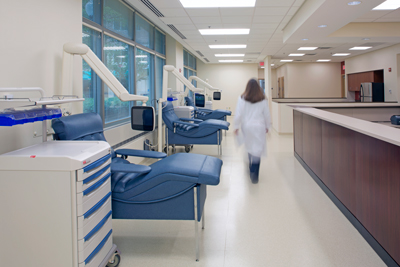 In June, the NIH Blood Bank opened a Platelet Donor Center in Rockville where all platelet donations will now take place.
In June, the NIH Blood Bank opened a Platelet Donor Center in Rockville where all platelet donations will now take place.
The Blood Bank collects blood and blood products for transfusions to NIH patients and collects blood components for research in NIH laboratories. To increase the Department of Transfusion Medicine's research capabilities of cell products, the NIH Blood Bank moved all platelet and granulocyte donations from the NIH Clinical Center to its new location at 5625 Fishers Lane, Rockville, Md., 20852.
Whole blood donations will continue to be accepted only at the NIH Blood Bank on the Bethesda campus.
Platelets are cells that help the blood to clot. Their job is to rush to the site of an injury. Once there, they form a barrier, help the damaged organ or blood vessel stop bleeding and give the body a chance to heal.
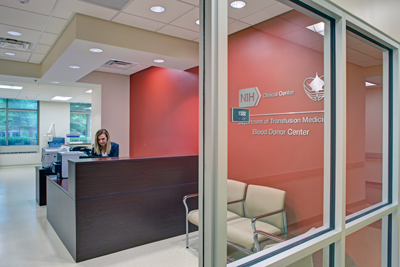 More than 30,000 units of platelets are transfused to treat patients undergoing cancer therapy, organ and tissue transplants and for other diseases. Platelet donation involves a two-hour process called plateletpheresis in which platelets are removed from whole blood, concentrated and collected.
More than 30,000 units of platelets are transfused to treat patients undergoing cancer therapy, organ and tissue transplants and for other diseases. Platelet donation involves a two-hour process called plateletpheresis in which platelets are removed from whole blood, concentrated and collected.
The new Platelet Donor Center has four platelet apheresis stations and one station for granulocyte donation. Granulocytes are a type of white blood cell that fight bacteria and fungi. Patients with bone marrow failure syndromes, or those undergoing chemotherapy or marrow transplantation, often do not make enough of their own granulocytes to prevent serious infections.
Walk–ins are welcome, but donors are encouraged to schedule an appointment in advance due to the length of the donation process. The center is adjacent to the Twinbrook Metro Station. Donors may use reserved parking in the garage behind the building.
Make an appointment online or call (301) 496- 4321.
Patients, staff gather as panelists to discuss importance of women's health
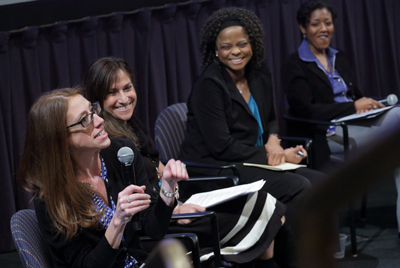 |
On May 14, panelist Jamie Gentille, far left, shared her experience as a child infected with HIV and the experience of joining a drug protocol which has allowed her to lead a happy and healthy life. Another patient as well as other NIH experts also shared their experiences and discussed the critical need for women in clinical trials. |
Throughout 2015, the Office of Research on Women's Health (ORWH) is celebrating twenty-five years of work to ensure that women's health research is a part of the scientific framework, not just at the NIH, but throughout the entire scientific community. In honor of this milestone and National Women's Health Week, the ORWH and the FDA's Office of Women's Health hosted a panel event "Meet the Faces of Clinical Research: Beyond Inclusion," [disclaimer] May 14.
In an interactive and at times heart wrenching panel discussion, clinical trial volunteers, Jamie Gentille and Juliana Ejedoghaobi, shared their unique paths and decisions to participate in a clinical trial at NIH. The two highlighted their important role as a member of their own research team and expressed what information may have been helpful in hindsight.
Ejedoghaobi declared that NIH is like "a secret she just wants to shout from the rooftop" and Gentille followed by stating that we "need to draw up the curtain to see all the magic that happens."
Dr. Janine Clayton, director of the ORWH, highlighted the importance of women and diversity in clinical research as well as the significant progress made in both policy and research since the office's establishment in 1990. She announced that "NIH will be taking action to assure that NIH funded researchers [also] account for sex as a biological variable in their pre-clinical research" because "males and females are different right down to their DNA."
The keynote address was given by Dr. Lauren V. Wood, senior clinical investigator with the National Cancer Institute (NCI), who called the panel gathering "a powerfully engaging and informative event."
Laura M. Lee, special assistant to the Deputy Director for Clinical Care and Patient Safety at the Clinical Center, encouraged and challenged everyone to "broaden [our] thinking about inclusion to include the active and deliberate engagement of patient participants in all aspects of clinical research."
Rounding out the conversation, Dr. Amina White, from the NIH Department of Bioethics, Dr. Adrienne Farrar, Chief of the Social Work Department and Dr. Lori Wiener, Director of the Psychosocial Support and Research Program within NCI, offered the provider perspective on engaging with patients in the research process and other challenges and experiences faced while working on clinical trials.
Panelists expressed the need to continue to share information about the resources NIH has and the existence and importance of clinical trials.
Marsha Henderson, FDA assistant commissioner for Women's Health closed the program by sharing her own personal experience as a clinical trial participant. She also said that the Office of Women's Health at FDA and the NIH ORWH will be "collaborating on a national campaign to raise awareness of the important of participation in clinical trials and of diverse participation of clinical trials." This will include "[sharing] best practices related to clinical research design, recruitment, retention and sub-population analysis" as well as "[conducting] educational research in select disease and therapeutic areas and convene scientific dialogues and identify training resource for investigators and health professionals."
Visit www.clinicaltrials.gov to learn more about participating in clinical trials.
NIH Minority Health Promotion Day
A Health Disparities Science Café took place April 30 in the Clinical Center atrium as part of NIH Minority Health Promotion Day in commemoration of National Minority Health Month. This year's theme, 30 Years of Advancing Health Equity; The Heckler Report: A Force for Ending Health Disparities in America, commemorates the 30th anniversary of the Report of the Secretary's Task Force on Black and Minority Health (also known as the Heckler Report). Guest speaker Kweisi Mfume, principal investigator of the Health Policy Research Consortium, a National Institute on Minority Health and Health Disparities Transdisciplinary Collaborative Center Program, and former U.S. Congressman and President and CEO of the National Association for the Advancement of Colored People, led a discussion on effectively communicating and disseminating science to inform public health policy. A health promotion exhibit featured NIH Institutes and Centers, the NIH Clinical Center Office of Patient Recruitment, the HHS Office of Minority Health Resource Center, and three local-area NIMHD grantees, the Maryland Center for Health Equity, the NIMHD Research Center On Latino Immigrant Refugee Health Disparities and the Health Policy Research Consortium, which all provided health promotion and education materials. |
Children arrive at the Clinical Center for a day of discovery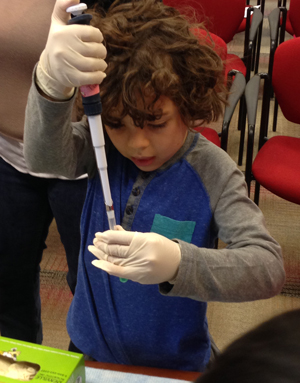 The 20th Annual NIH Take Your Child to Work Day brought school-aged children to NIH for a day of discovery. Employees from all over NIH showed children the important work that NIH does and let them explore the occupations that support the public health services NIH delivers. Twenty-six Institutes and Centers sponsored over 500 sessions of 149 activities. Here, Maxwell Kuehn (age 7) concentrates on pipetting. |
NIH recruiting for upcoming studies
NICHD seeks healthy, overweight children 7 to 11 years old to join in a research study. Researchers want to learn if breaking up sitting with short periods of activity improves children's metabolism and attention. Compensation will be provided. Parents/guardians must give permission for children to participate. (Study 13-CH-0169)
NIMH is studying people with anxiety and how they respond to stressful events. Researchers are seeking those with general anxiety, panic, and/or social anxiety disorder. One to two outpatient visits to the Clinical Center. Compensation will be provided. (Study 03-M-0093)
NICHD seeks adults who are overweight, have high blood pressure and/or pre-diabetes to participate in a study. Researchers are examining the effects of the medication, colchicine on the complications of obesity. Compensation is provided. (Study 14-CH-0119)
Have you been treated for HER-2 positive breast cancer? NHLBI researchers want to learn more about the risks of developing heart disease in women who have received treatment for breast cancer. One study visit to the NIH Clinical Center. Compensation is provided. (Study 10-H-0126)
For more information contact the Office of Patient Recruitment (Hablamos español): 1-866-444-2214 (TTY 1-866-411-1010). Read about the studies at www.clinicaltrials.gov.
Upcoming Events
Most lectures will be streamed live and archived
The Children's Inn at NIH: 25th Anniversary Symposium
At the Intersection of Hope & Science: 25 Years of Advancing Medical Discoveries
June 18, 2015, 2:00 p.m. – 5:30 p.m.
Masur Auditorium
The symposium will highlight The Inn's history, especially its role in advancing medical research. Physicians and families will share their stories and scientific advances. The event will look to the future of The Inn and the next 25 years of medical discovery.
Clinical Center Grand Rounds Lecture
Hematopoietic Stem Cell Transplantation: Perspectives; T Cell Transplantation: Developments
June 24, 2015, Noon – 1:00 p.m.
Lipsett Amphitheater
Presented by Crystal Mackall, MD, NCI and Ronald Gress, MD, NCI.
8th Annual Siblings Day: Celebrating 'Super Sibs' [disclaimer]
July 14, 2015, 9:00 a.m. – 3:30 p.m.
Clinical Center and the Children's Inn at NIH
A day to enable patients' brothers and sisters to feel proud of the important role that they play at home and on the health care team. The day will include hands-on art activities, lunch, therapeutic games and a "Super Sib" award ceremony and ice cream social. Open to the siblings of Clinical Center pediatric patients. Registration required.
NOTE: PDF documents require the free Adobe Reader.
 The information on this page is archived and provided for reference purposes only.
The information on this page is archived and provided for reference purposes only.